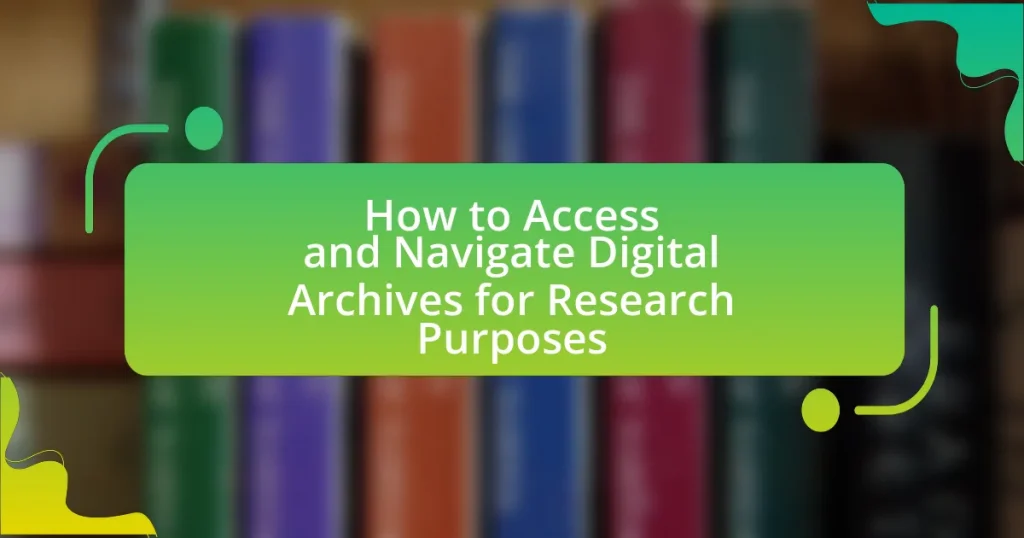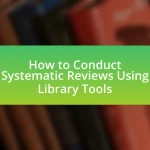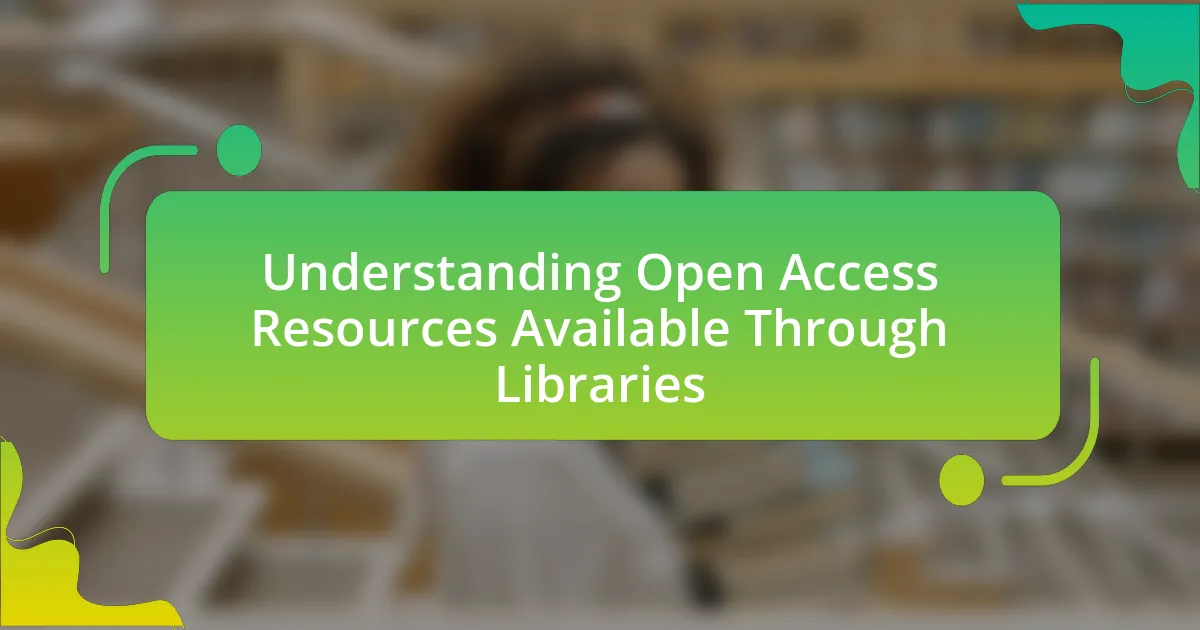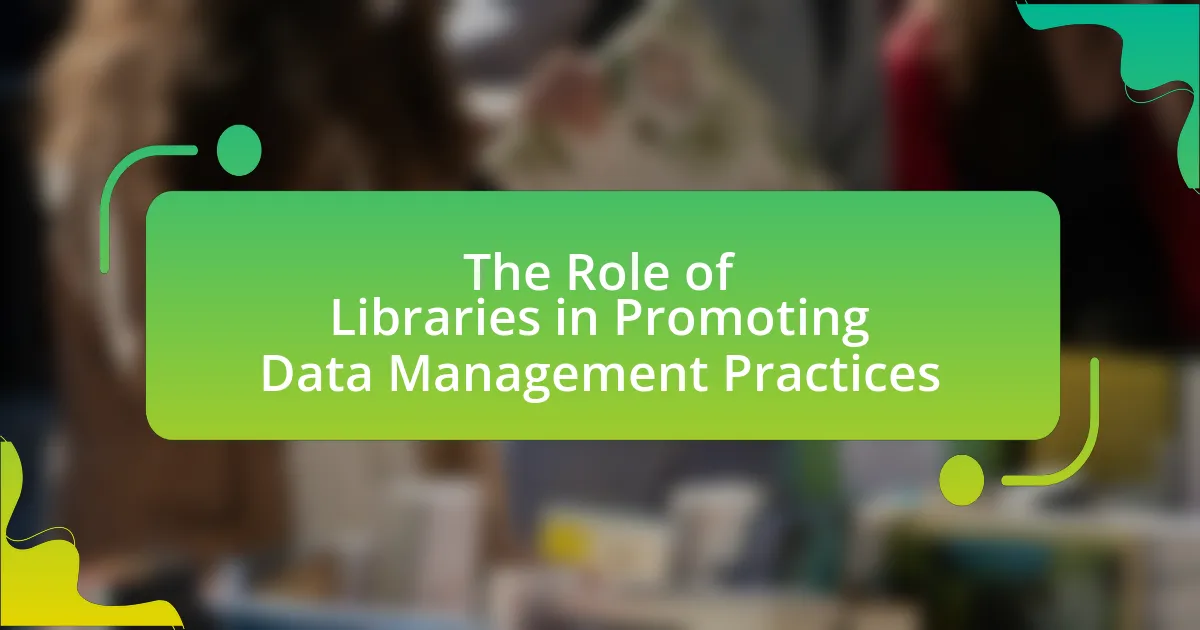Digital archives are electronic collections of digitized documents, records, and materials that enhance research accessibility and preservation. This article explores the significance of digital archives, highlighting their differences from traditional archives, the types of materials they contain, and the technologies that support them. It also addresses challenges researchers face when accessing these archives, strategies for effective navigation, and best practices for evaluating the credibility of sources. Additionally, practical tips for improving the research experience within digital archives are provided, emphasizing the importance of utilizing advanced search techniques and understanding metadata.
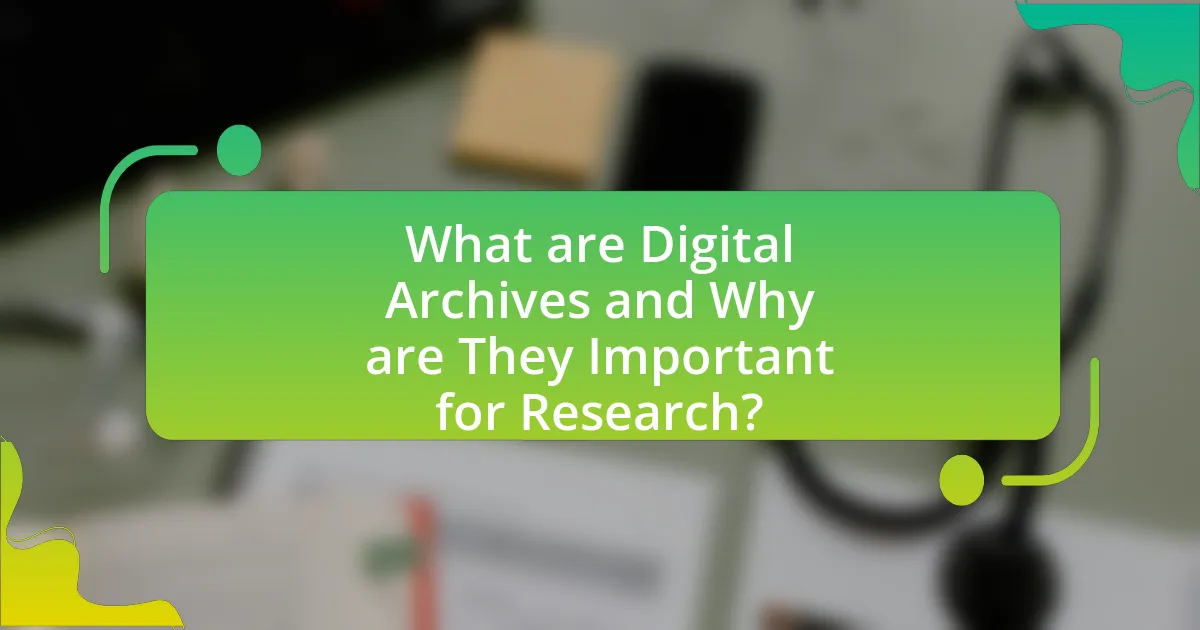
What are Digital Archives and Why are They Important for Research?
Digital archives are collections of digitized documents, records, and other materials that are stored electronically for preservation and access. They are important for research because they provide scholars and researchers with easy access to primary sources, enhance the ability to conduct comprehensive studies, and facilitate the preservation of historical materials. For instance, the National Archives in the United States has digitized millions of documents, allowing researchers to explore historical data without the constraints of physical access, thus promoting broader participation in research activities.
How do Digital Archives differ from Traditional Archives?
Digital archives differ from traditional archives primarily in their format and accessibility. Digital archives store information in electronic formats, allowing for easier and faster access through online platforms, while traditional archives consist of physical documents that require in-person visits for access. For instance, digital archives can be searched using keywords, enabling users to locate specific information quickly, whereas traditional archives often necessitate manual searching through physical files. This shift to digital formats has been supported by the increasing use of technology in information management, with studies indicating that digital archives can significantly enhance research efficiency and accessibility.
What types of materials can be found in Digital Archives?
Digital archives contain a variety of materials, including documents, photographs, audio recordings, video files, maps, and datasets. These materials are often digitized versions of physical items, such as manuscripts, newspapers, and historical records, making them accessible for research and educational purposes. The presence of these diverse formats allows researchers to explore a wide range of subjects and historical contexts, enhancing the depth and breadth of their inquiries.
Why is digitization significant for preserving historical documents?
Digitization is significant for preserving historical documents because it creates digital copies that safeguard against physical deterioration and loss. Historical documents are often fragile and susceptible to damage from environmental factors, handling, and time. By converting these documents into digital formats, institutions can ensure their longevity and accessibility. For instance, the Library of Congress has digitized millions of items, allowing broader public access while protecting the originals from wear and tear. This process not only preserves the content but also enhances discoverability, enabling researchers to access materials remotely and efficiently.
What are the key features of Digital Archives?
Digital archives are characterized by several key features that enhance accessibility and preservation of information. Firstly, they provide digitized collections of documents, images, and multimedia, allowing users to access materials remotely. Secondly, digital archives often include advanced search functionalities, enabling users to locate specific items quickly through metadata and indexing. Additionally, they support various formats, ensuring compatibility with different devices and software. Furthermore, digital archives typically incorporate preservation strategies, such as regular backups and migration to new formats, to safeguard against data loss. Lastly, many digital archives offer user-friendly interfaces that facilitate navigation and engagement, making research more efficient.
How is metadata utilized in Digital Archives?
Metadata is utilized in digital archives to provide structured information about the content, context, and structure of digital objects. This structured information enables efficient organization, retrieval, and management of archived materials. For instance, metadata elements such as title, author, date, and subject keywords facilitate searchability and help users locate specific items quickly. Additionally, standardized metadata schemas, like Dublin Core, enhance interoperability between different digital archives, allowing for seamless access and navigation across platforms. This systematic approach to metadata ensures that researchers can effectively discover and utilize relevant resources in their studies.
What technologies support the functionality of Digital Archives?
Digital archives are supported by technologies such as cloud storage, metadata standards, digital asset management systems, and content management systems. Cloud storage enables scalable and secure storage solutions for large volumes of digital content, while metadata standards like Dublin Core facilitate the organization and retrieval of archived materials. Digital asset management systems provide tools for cataloging, preserving, and accessing digital files, and content management systems allow for the creation, editing, and publishing of digital content. These technologies collectively enhance the accessibility and usability of digital archives for research purposes.
What challenges do researchers face when accessing Digital Archives?
Researchers face several challenges when accessing digital archives, including issues related to data availability, technological barriers, and copyright restrictions. Data availability can be limited due to incomplete digitization of materials, which restricts access to essential documents. Technological barriers arise from the need for specific software or hardware to access certain archives, which may not be readily available to all researchers. Additionally, copyright restrictions can hinder access to digital content, as many archives impose limitations on the use and reproduction of their materials. These challenges collectively complicate the research process and can delay or obstruct the acquisition of necessary information.
How can access restrictions impact research outcomes?
Access restrictions can significantly limit research outcomes by hindering the availability of essential data and resources. When researchers face barriers such as paywalls, limited access to archives, or restricted datasets, their ability to conduct comprehensive analyses is compromised. For instance, a study published in the journal “PLOS ONE” found that restricted access to scientific literature can lead to gaps in knowledge and hinder innovation, as researchers may miss critical findings that could inform their work. Furthermore, access limitations can exacerbate inequalities in research opportunities, as institutions with fewer resources may struggle to obtain necessary materials, ultimately affecting the quality and breadth of research produced.
What are common technical issues encountered in Digital Archives?
Common technical issues encountered in digital archives include data corruption, format obsolescence, and inadequate metadata. Data corruption can occur due to hardware failures or software bugs, leading to loss of information. Format obsolescence happens when file formats become outdated, making it difficult to access or interpret archived materials; for instance, older formats like .doc or .xls may not be supported by current software. Inadequate metadata can hinder effective search and retrieval, as insufficient or poorly structured metadata makes it challenging to locate relevant documents. These issues are documented in various studies, highlighting the importance of maintaining digital archives to ensure long-term accessibility and usability.

How to Access Digital Archives Effectively?
To access digital archives effectively, users should start by identifying specific archives relevant to their research topic, such as national libraries, university repositories, or specialized databases. Once identified, users can utilize advanced search features, keywords, and filters to narrow down results, ensuring they find pertinent materials quickly. For instance, the Library of Congress offers a comprehensive digital collection that can be accessed through its website, allowing users to search by subject, date, or format. Additionally, understanding the archive’s organization and available tools, such as citation guides or user support, enhances the research experience.
What steps should be taken to locate relevant Digital Archives?
To locate relevant Digital Archives, start by identifying specific topics or keywords related to your research. Utilize academic databases such as JSTOR, Google Scholar, or institutional repositories to search for digital collections. Next, visit the websites of libraries, museums, and universities that often host digital archives, and use their search functionalities to find pertinent materials. Additionally, explore specialized digital archive platforms like the Digital Public Library of America or Europeana, which aggregate resources from various institutions. Finally, consult bibliographies or reference lists in academic publications to discover additional digital archives that may not be immediately visible through general searches.
How can search engines and databases be used to find Digital Archives?
Search engines and databases can be used to find digital archives by utilizing specific search queries and filters that target archival content. Search engines like Google allow users to enter keywords related to the desired archives, often including terms like “digital archive,” “repository,” or specific topics of interest, which can yield results from various digital collections. Databases, such as JSTOR or Archive.org, provide structured access to digital archives through advanced search options, allowing users to filter results by date, format, or subject matter. For instance, using the advanced search feature on Archive.org enables users to locate specific types of media, such as books or audio files, within its extensive digital library. This targeted approach enhances the efficiency of locating relevant digital archives for research purposes.
What role do institutional subscriptions play in accessing Digital Archives?
Institutional subscriptions are crucial for accessing digital archives as they provide authorized users, such as students and faculty, with comprehensive access to a wide range of resources. These subscriptions often include databases, journals, and primary source materials that are otherwise behind paywalls. For instance, many academic institutions subscribe to platforms like JSTOR or ProQuest, which host extensive digital archives, enabling users to retrieve valuable historical documents and research articles necessary for scholarly work. This access is essential for conducting thorough research, as it allows users to utilize a breadth of information that supports academic inquiry and innovation.
What tools and resources are available for accessing Digital Archives?
Digital archives can be accessed using various tools and resources, including online databases, digital libraries, and specialized software. Online databases such as JSTOR and Project MUSE provide access to a wide range of academic journals and primary sources. Digital libraries like the Internet Archive and Europeana offer extensive collections of digitized materials, including books, photographs, and manuscripts. Additionally, specialized software such as Omeka and ArchivesSpace facilitates the organization and presentation of digital collections, making it easier for researchers to navigate and utilize these resources effectively.
How can researchers utilize library services for Digital Archives access?
Researchers can utilize library services for Digital Archives access by leveraging institutional subscriptions and specialized databases that libraries provide. Libraries often offer access to a wide range of digital archives, including historical documents, manuscripts, and multimedia resources, which are not freely available online. For instance, many academic libraries subscribe to platforms like JSTOR, ProQuest, or specific digital collections that house primary source materials. Additionally, librarians can assist researchers in navigating these resources effectively, providing guidance on search strategies and access protocols. This support enhances the research process by ensuring that researchers can locate and utilize relevant digital materials efficiently.
What are the benefits of using specialized software for navigating Digital Archives?
Specialized software for navigating digital archives enhances efficiency, accuracy, and user experience. This software often includes advanced search functionalities, allowing users to quickly locate specific documents or data within vast collections, which is crucial for research purposes. Additionally, it typically offers tools for organizing and annotating materials, facilitating better management of information. For instance, software like ArchivesSpace or Omeka provides customizable metadata fields, enabling researchers to tailor their searches and improve retrieval rates. Furthermore, specialized software often supports various file formats and integrates with other digital tools, streamlining workflows and enhancing collaboration among researchers.
What strategies can enhance the research experience in Digital Archives?
Utilizing advanced search techniques significantly enhances the research experience in digital archives. Researchers can employ Boolean operators, such as AND, OR, and NOT, to refine their queries and filter results more effectively. Additionally, leveraging metadata and subject headings allows for more precise searches, as these elements provide context and categorization for archived materials. Studies indicate that users who apply these strategies can reduce search time by up to 50%, leading to more efficient research outcomes.
How can researchers develop effective search queries for Digital Archives?
Researchers can develop effective search queries for digital archives by utilizing specific keywords, Boolean operators, and advanced search techniques. By identifying relevant keywords that accurately reflect the research topic, researchers can enhance the precision of their queries. Incorporating Boolean operators such as AND, OR, and NOT allows for more complex searches, enabling researchers to refine their results further. Additionally, using quotation marks for exact phrases and truncation symbols can help in retrieving more targeted information. Studies have shown that structured search strategies significantly improve the retrieval of relevant documents in digital archives, as evidenced by research conducted by the Digital Library Federation, which highlights the importance of query formulation in information retrieval success.
What techniques can be employed to organize and manage findings from Digital Archives?
Techniques to organize and manage findings from digital archives include the use of metadata standards, digital asset management systems, and systematic categorization. Metadata standards, such as Dublin Core or MODS, facilitate the consistent description of digital objects, making retrieval easier. Digital asset management systems provide a centralized platform for storing, organizing, and accessing digital content, enhancing efficiency in managing large volumes of data. Systematic categorization involves creating a structured framework for organizing findings based on themes, dates, or types of materials, which aids in quick navigation and retrieval. These techniques are validated by their widespread adoption in libraries and archives, demonstrating their effectiveness in improving access and management of digital resources.
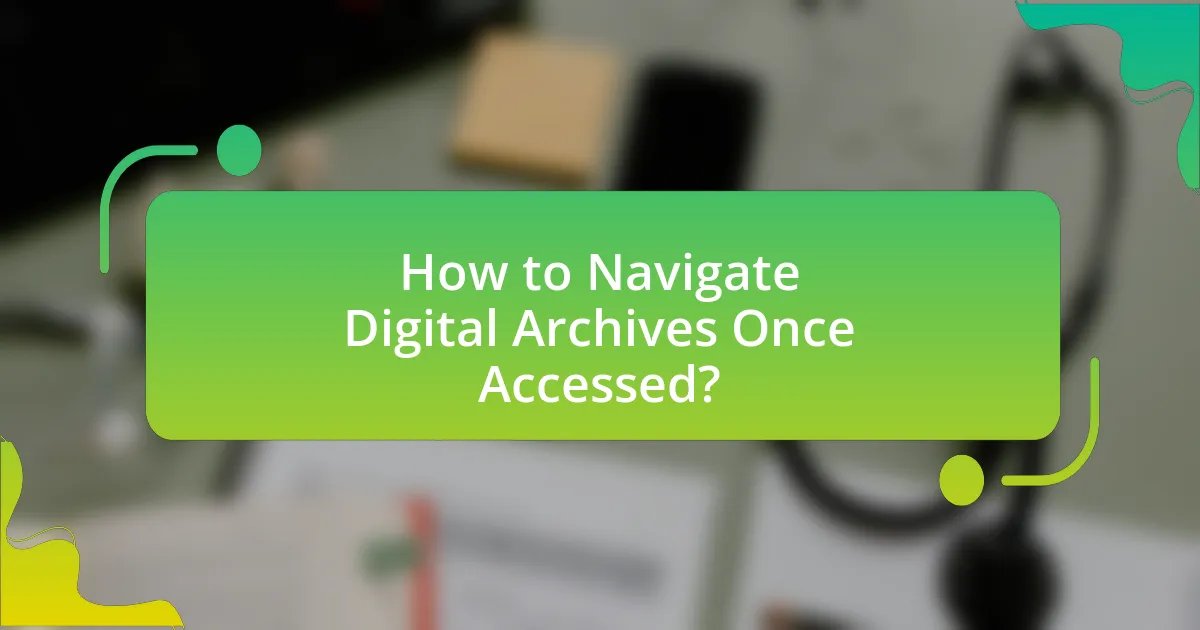
How to Navigate Digital Archives Once Accessed?
To navigate digital archives once accessed, utilize the search functionality to locate specific documents or topics of interest. Most digital archives provide advanced search options, allowing users to filter results by date, author, or subject matter, which enhances the efficiency of finding relevant materials. Additionally, familiarize yourself with the archive’s organizational structure, such as categories or collections, to better understand how information is grouped. This structured approach is supported by the fact that many digital archives, like the Library of Congress Digital Collections, categorize their resources to facilitate user navigation.
What are the best practices for navigating Digital Archives?
The best practices for navigating digital archives include using advanced search features, familiarizing oneself with the archive’s structure, and utilizing metadata effectively. Advanced search features allow users to refine queries, leading to more relevant results. Understanding the archive’s organization, such as categories and collections, enhances navigation efficiency. Additionally, leveraging metadata, which provides context and details about the materials, aids in locating specific items and understanding their significance. These practices improve the overall research experience and increase the likelihood of finding pertinent information.
How can users effectively use filters and advanced search options?
Users can effectively use filters and advanced search options by applying specific criteria to narrow down search results. This includes selecting date ranges, document types, and keywords relevant to their research topic. For instance, utilizing Boolean operators like AND, OR, and NOT can refine searches further, allowing users to combine or exclude terms to achieve more precise results. Research indicates that users who employ these strategies can increase the relevance of their findings by up to 50%, as demonstrated in studies on information retrieval efficiency.
What navigation tools are commonly available in Digital Archives?
Digital archives commonly offer navigation tools such as search functions, filters, and browsing categories. Search functions allow users to input keywords to locate specific documents or items quickly. Filters enable users to narrow down results based on criteria like date, format, or subject matter, enhancing the efficiency of the search process. Browsing categories provide a structured way to explore collections by themes or topics, facilitating easier access to related materials. These tools collectively improve user experience and streamline the research process within digital archives.
How can researchers evaluate the credibility of sources found in Digital Archives?
Researchers can evaluate the credibility of sources found in digital archives by assessing the authority, accuracy, objectivity, currency, and coverage of the materials. Authority involves checking the author’s qualifications and institutional affiliation, which can indicate expertise. Accuracy requires verifying the information against other reliable sources to ensure it is factual. Objectivity assesses potential biases in the content, while currency examines the timeliness of the information, ensuring it is up-to-date. Coverage involves evaluating the comprehensiveness of the source in relation to the research topic. These criteria are supported by established guidelines from organizations such as the American Library Association, which emphasizes the importance of critical evaluation in research practices.
What criteria should be used to assess the reliability of Digital Archive content?
To assess the reliability of Digital Archive content, one should evaluate the source’s credibility, the accuracy of the information, and the context in which the content was created. Credible sources typically include established institutions, such as universities or government agencies, which have a reputation for maintaining high standards of accuracy and integrity. Accuracy can be verified by cross-referencing the information with other reliable sources or checking for citations and references within the content. Additionally, understanding the context, including the purpose of the archive and the date of the material, helps determine its relevance and reliability for research purposes.
How can cross-referencing with other sources enhance credibility checks?
Cross-referencing with other sources enhances credibility checks by providing multiple points of verification for the information presented. When researchers compare data or claims from various sources, they can identify inconsistencies or corroborate facts, which strengthens the reliability of the information. For instance, a study published in the Journal of Information Science found that cross-referencing significantly reduces the likelihood of accepting false information, as it allows for a more comprehensive evaluation of the evidence. This method not only confirms the accuracy of the content but also helps in identifying biases or gaps in individual sources, thereby promoting a more thorough understanding of the subject matter.
What are some common pitfalls to avoid when using Digital Archives?
Common pitfalls to avoid when using digital archives include neglecting to verify the authenticity of sources, overlooking metadata, and failing to consider copyright restrictions. Verifying authenticity is crucial because many digital archives may contain inaccurate or misleading information, which can compromise research integrity. Metadata provides essential context about the materials, such as creation date and authorship, and ignoring it can lead to misinterpretation. Additionally, copyright restrictions can limit the use of certain materials, and not understanding these limitations can result in legal issues.
How can misinterpretation of digital materials be prevented?
Misinterpretation of digital materials can be prevented by ensuring clarity in presentation and providing context. Clear labeling, concise summaries, and comprehensive metadata enhance understanding, reducing the likelihood of misinterpretation. Research indicates that well-structured digital archives, such as those outlined in the Digital Preservation Coalition’s guidelines, significantly improve user comprehension and accuracy in interpreting materials. By implementing these practices, users can navigate digital archives more effectively, minimizing errors in understanding the content.
What are the risks of relying solely on Digital Archives for research?
Relying solely on digital archives for research poses several risks, including the potential for incomplete data, loss of context, and issues with data authenticity. Digital archives may not encompass all available materials, leading to gaps in research findings. For instance, certain historical documents may only exist in physical form, which can result in a skewed understanding of a topic if researchers do not access these materials. Additionally, digital formats can strip away contextual information, such as annotations or marginalia, that provide critical insights into the material. Furthermore, the authenticity of digital documents can be questionable, as they may be subject to manipulation or misrepresentation, undermining the reliability of the research. These factors highlight the importance of using a diverse range of sources, including physical archives, to ensure comprehensive and accurate research outcomes.
What practical tips can improve your experience with Digital Archives?
To improve your experience with digital archives, utilize advanced search features effectively. These features often include filters for date ranges, document types, and specific keywords, allowing for more precise results. For instance, using Boolean operators can refine searches, leading to quicker access to relevant materials. Additionally, familiarize yourself with the archive’s organizational structure, as understanding categories and collections can streamline navigation. Engaging with user guides or tutorials provided by the archive can also enhance your ability to locate and utilize resources efficiently.
